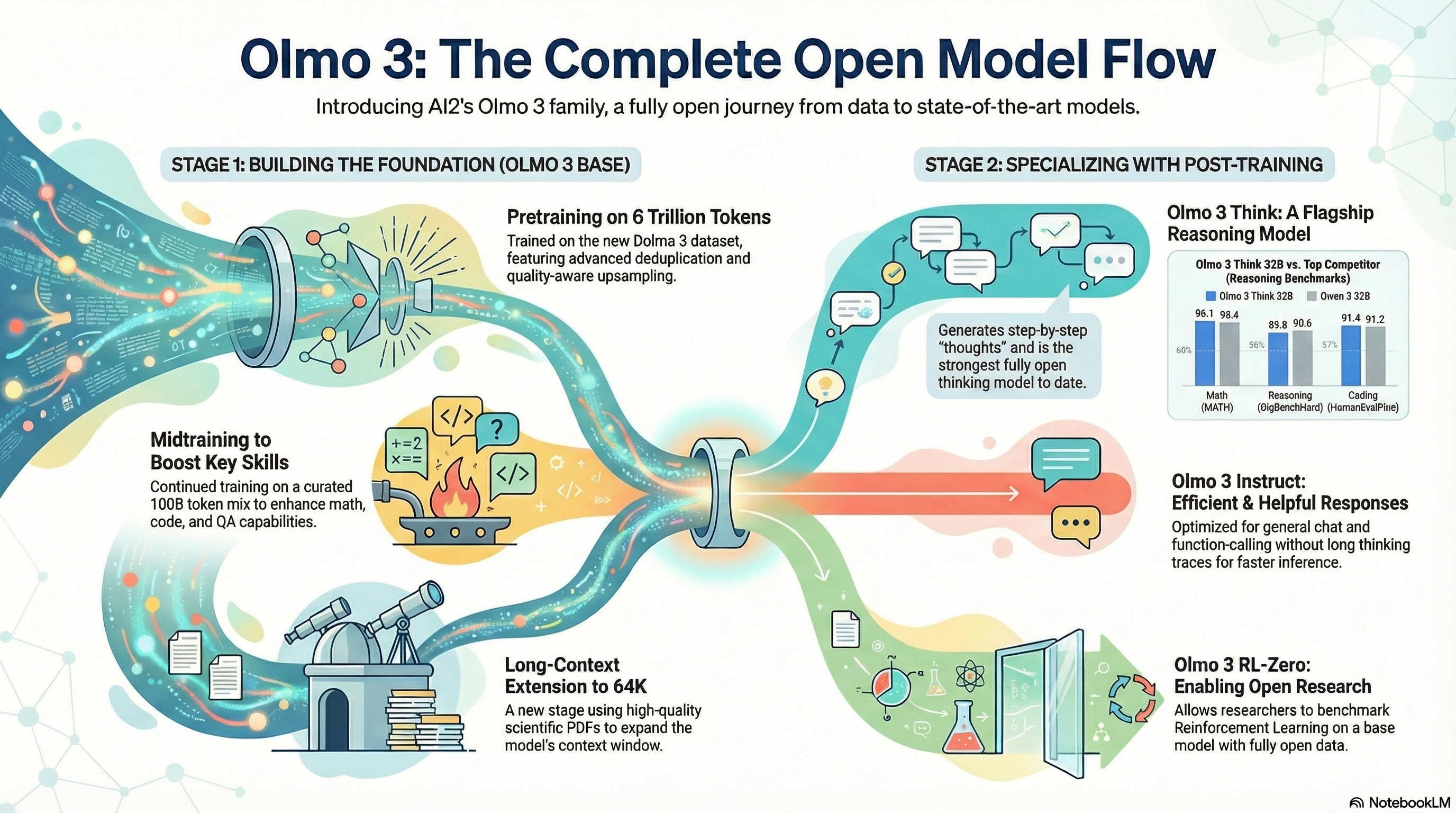Olmo3 Open Reasoning Llm
The Allen Institute for AI (AI2) has released Olmo 3, an open reasoning LLM. This post outlines an overview.
The Allen Institute for AI (AI2) has released Olmo 3, a new family of state-of-the-art, fully open language models. Available at 7B and 32B parameter scales, Olmo 3 models are engineered for long-context reasoning, function calling, coding, instruction following, general chat, and factual recall.
What sets Olmo 3 apart is not just raw capability—it’s the unprecedented commitment to complete transparency across the entire development pipeline.
Radical Transparency: The Entire Model Flow, Open to All
Olmo 3 is built on a philosophy of full lifecycle openness. AI2 has released:
- Every checkpoint
- Every datapoint and dataset mix
- Every dependency and training stage
This means researchers and builders can intervene at any point in the process—pretraining, midtraining, post-training, RL, or evaluation. Instead of offering only final model weights, Olmo 3 provides a fully open model flow.
The result is one of the most customizable and auditable open model families ever released.
The Olmo 3 Model Family
Olmo 3 includes several specialized variants tailored for different use cases:
1. Olmo 3 Base
Models: Olmo-3-1025-7B, Olmo-3-1125-32B
The Base models provide a strong general-purpose foundation. The 32B variant substantially outperforms other fully open models in math and code and rivals the most capable open-weight models overall.
2. Olmo 3 Think
Models: Olmo-3-7B-Think, Olmo-3-32B-Think
The flagship reasoning models. Think variants are trained to generate extended thinking traces before responding, boosting complex reasoning.
The 32B model is currently the strongest fully open reasoning model and matches top open-weight competitors (e.g., Qwen 3 32B) despite being trained on ~6× fewer tokens.
3. Olmo 3 Instruct
Model: Olmo-3-7B-Instruct
The Instruct line is optimized for concise, helpful, user-facing responses—and intentionally avoids exposing internal chain-of-thought.
It outperforms models like Qwen 2.5, Gemma 3, and Llama 3 at comparable scales.
4. Olmo 3 RL-Zero
Models:
Olmo-3-7B-RLZero-MathOlmo-3-7B-RLZero-Code
This pathway enables researchers to run Reinforcement Learning with Verifiable Rewards (RLVR) starting from a clean base model. It provides a uniquely open benchmark for studying how pretraining data influences RL-driven performance.
How Olmo 3 Is Built: The Model Flow
Olmo 3 development spans two major phases: pretraining and post-training.
Phase 1: Base Model Training
The base models are trained in three sequential stages:
| Stage | Data Mix | Purpose |
|---|---|---|
| 1. Pretraining | Dolma 3 Mix | Establishes the core model, trained up to 5.9T tokens. Includes global deduplication and large-scale PDF ingestion via olmOCR. |
| 2. Midtraining | Dolma 3 Dolmino Mix | Adds 100B curated tokens targeting code, math, and QA. Begins establishing patterns for instruction following and thinking traces. |
| 3. Long-Context Extension | Dolma 3 Longmino Mix | Extends the model to support 64K context using long documents, including scientific PDFs processed with olmOCR. |
Architecturally, the model uses:
- An 8192-token window during initial stages
- Sliding Window Attention (SWA) in 3 of every 4 layers
- Efficient long-sequence scaling during extension
These design choices allow Olmo 3 to train deeply and efficiently at long context lengths.
Phase 2: Post-Training Pipeline
Post-training unlocks the specialized Think, Instruct, and RL-Zero variants. This phase is powered by Dolci, a new high-quality data suite designed for:
- Instruction following
- Reasoning and chain-of-thought
- Function calling
- Reinforcement learning
The core pipeline includes:
1. Supervised Fine-Tuning (SFT)
Uses datasets such as Dolci Think SFT and Dolci Instruct SFT to establish the baseline behaviors required by each model family.
2. Preference Optimization (DPO)
Applies Direct Preference Optimization using curated preference datasets (e.g., Dolci Think DPO).
DPO strengthens reasoning and alignment through Delta Learning—a contrastive method that refines outputs without overfitting.
3. Reinforcement Learning with Verifiable Rewards (RLVR)
Uses the new OlmoRL framework to scale RL across multiple domains beyond math and code.
Key improvements include:
- Up to 4× faster RL training
- Generalizable verifiable objective functions
- Stable training from both SFT and DPO starting points
(though DPO → RLVR proved strongest for Think models)
For Instruct models, additional datasets refine function calling and enforce concise, direct responses.
Why Olmo 3 Matters
Olmo 3 represents a milestone in open research ecosystems:
- Full transparency from raw data to final model
- Industry-competitive performance at 7B and 32B scales
- Dedicated models for reasoning, instruction following, and RL research
- A reproducible, extensible pipeline for the community
By releasing everything, AI2 has created not just a model—but an open platform for inventing the next generation of AI systems.

